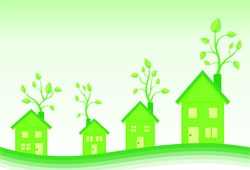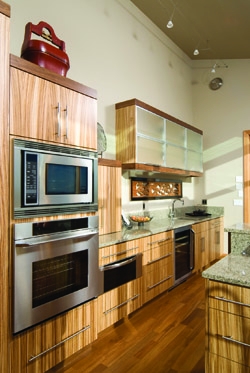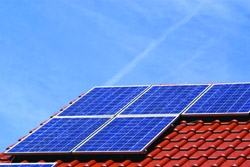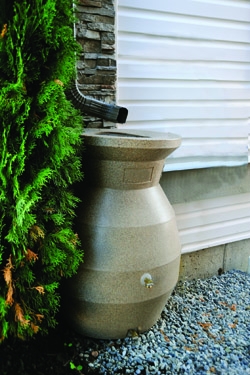
Remodeling your home to be more eco-friendly is more expensive up front, but pays high dividends.
Cost vs. Benefit
REMODELING YOUR HOME TO BE MORE ENVIRONMENTALLY FRIENDLY WILL COST MORE THAN A STANDARD RENOVATION. TRUE OR FALSE? THE ANSWER IS TRUE—AND FALSE.

A backsplash of recycled glass tile will cost more than, say, porcelain tile—and, beyond aesthetic appeal, there’ll be no significant return on your investment.
More efficient windows and insulation will also cost more. But you’ll see an immediate payback through lower energy bills. Likewise, water-saving plumbing fixtures may require a higher up-front in-vestment. But your water bill will decrease and the investment will be recouped over time.
Durable, long-lasting building materials are in-variably more costly. But they last longer and won’t need to be replaced or repaired as often.
You get the picture. “Some green household products cost more to buy but ultimately generate savings, either directly in the form of cash or indirectly in the form of an improved quality of life,” says remodeler Cathy Byrd of Innovative Restorations. “Many accomplish both.”
However, Byrd notes that green remodeling hasn’t caught on in Tampa">Tampa Bay as much as it has in other parts of Florida. “I think it’s due to a lack of real understanding of what ‘green’ really is,” she says.
The green building movement is all about producing durable homes that use fewer natural resources and protect indoor air quality.
Such homes may be built using expensive strategies such as using solar panels to harness the power of the sun. Or there are inexpensive green approaches such as using roof overhangs to ward off solar heat gain.
Green homes are constructed from products and materials that have one or more of these eco-friendly features: Recycled, recyclable, renewable, nontoxic, natural, biodegradable, reclaimed and sustainably harvested.
Building an environmentally responsible home is good, says Tampa">Tampa Bay remodeler Wes Jenkins of Blue Diamond Builders in Largo. But renovating an existing home to be green is even better.
“People think of green building as involving specific eco-friendly products such as bamboo flooring,” says Jenkins. “But the green movement is also about salvaging and reusing existing structures and materials.”
Remodeling an existing home, adds Jenkins, is inherently green. Now kick it up a notch by using a few simple strategies during the remodeling project and you’ll be getting a more comfortable home that conserves natural resources while saving you money.
Salvage whatever you can from your existing structure. Install energy- and water-efficient features. Choose local, natural, renewable products that have no added toxins.
Consider not only the initial cost of the products you use, but also what kind of a return you’ll get on your investment. You can go green on a budget—especially with all the federal tax credits now available—and your contractor can show you how.
 Green Defined
Green Defined
“Green building is not a one-size fits all,” says Tampa">Tampa Bay remodeler John Marzulli of Emerald Contractors in Tarpon Springs. “You’ve got to take the client and look at their lifestyle and see what makes sense for them.”
Marzulli is one of several local remodelers already incorporating green ideas, products and materials into local renovation projects.
“As the prices come down, people are more and more willing to use green products,” he says.
Gas tankless water heaters, bamboo floors, nontoxic paint and high-efficiency air conditioners are particularly popular, Marzulli adds.
Greaves Construction in Temple Terrace also incorporates a variety of eco-friendly products into its projects, including low-flow toilets, hot-water recirculation pumps, energy-efficient windows and appliances.
Plus, says contractor Jon Greaves, “We save things for reuse. In an old house, we save all the trim and studs. There’s no sense in trashing all this stuff. We try to separate our construction debris. We take everything usable to Habitat for Humanity.”
 Energy Effiency
Energy Effiency
Energy efficiency is still the driving force behind the green building movement “because it’s like making an investment in your future,” says Tampa">Tampa Bay contractor Guy Pearson of Safety Harbor Custom Builders. You’ll trim your power bill every month, and, in time, pro-ducts such as solar water heaters and highly efficient insulation will pay for themselves, he adds.
Greaves agrees. “Green to me is just all about energy efficiency,” he says. “You want to have your exterior envelope as efficient as possible. Use high-efficiency windows and doors. Use an upgraded air conditioning unit and water heater. Get the house as efficient as possible because then you’re saving money.”
It might cost a little more up front, but it’ll pay for itself in a few years, Greaves adds. “You’re saving money and reducing your carbon footprint,” he says. “And that’s good for everybody.”
If energy efficiency is your main goal, Jenkins suggests that you bump up your insulation to R-30. “That’s going to get you the best return on your money,” he says.
Every type of insulation has an R-value, which is the standard measure of resistance to heat flow.
The higher the R-value, the great-er the resistance.
Fiberglass is the most common type of insulation, with R-values ranging from R-11 to R-38 depending upon thickness. But there are newer, more eco-friendly insulation materials such as spray-in cellulose insulation, which is made from recycled newspapers.
Also on the market is a spray foam insulation that expands and fills gaps for extra efficiency. A green-minded contractor can describe the pros and cons of insulation choices.
For energy-efficiency, consider newer construction technologies such as structural insulated panels, says Marzulli. The panels, essentially a “sandwich” consisting of two layers of structural board with an insulating layer of foam in between, are used in floors, walls and roofs.
“The SIPs are very green and sustainable and are a structurally sound product,” Marzulli adds. “I’m impressed (with SIPs) and I’ll push it with clients when I can.”
There are lower-cost strategies for making your home more energy efficient as well, says St. Petersburg contractor Neal Fiske of TriplePoint Construction.
“Use landscaping that’s strat-egically placed to block the sun, or do something as simple as building a 24-inch overhang instead of a 16-inch overhang,” Fiske adds. “Also, talk to your contractor about using a more efficient air conditioning unit and Energy Star-rated appliances.”
 Water Conservation
Water Conservation
After you’ve incorporated energy conservation practices and products, think about how you can trim water usage using water-efficient appliances and fixtures, Jenkins says.
“The bathroom offers huge opportunities to save water,” Jenkins adds. “Make sure you change out all of your fixtures so they are water-saver fixtures. Put in a new low-flow or dual-flush toilet. Get water-saver shower fixtures.”
You don’t have to put a lot of money out to get a big return, Jenkins says. If you have natural gas or propane, consider changing out the water heater to a tankless system. “You’ll probably return that cost within two years,” he adds.
Local experts also offer several tips for conserving water outdoors. Plant drought-tolerant, water-wise plants; collect and store rainwater for irrigation; install permeable paving that allows rainwater to seep back into the ground; and use drip irrigation systems that deliver a steady drip of water directly to the plants that need it most.
Green building and remodeling guidelines call for energy efficiency and resource conservation, which can save homeowners money as well as preserve the planet. But those same guidelines also call for products that protect the health of homeowners.
Indoor Air Quality
Building materials and products such as paint, adhesives and carpeting often contain volatile organic compounds that negative-ly affect indoor air quality. But there are greener alternatives.
“For floors, pull out that old carpet that’s full of all kinds of disgusting stuff and go to something like tile or engineered wood products,” Jenkins says. “It doesn’t take a lot of trees to make it. You’ll get a good green floor and improve the air quality of your home at the same time.”
Carpeting, in general, is frown-ed upon by green advocates because it attracts dust and allergens, contains toxic chemicals and has a relatively short lifespan, which means it’ll end up in landfills.
But if you like the feeling of softness underfoot, consider more sustainable choices such as rugs made from natural, renewable fibers or recycled content.
Other environmentally sound flooring choices include bamboo, which is a rapidly renewable resource; reclaimed wood, which is salvaged from existing structures; and harvested wood that has been certified by the Forest Stewardship Council. The certification means that the wood came from a managed forest. ?Also, ask for finishes that are water-based or contain low- or no VOCs.
Ventilation systems also are important for indoor air quality, says Fiske. “We build homes tighter now for energy efficiency,” Fiske adds. “And the tighter you build a structure the more concerned you have to be with indoor air quality.”
Filters are a relatively inexpensive way to capture airborne articulates. And vent all exhaust from the bathroom and kitchen to the outside, Fiske says.
To be considered green, a material, product or practice should help reduce energy or water use, preserve indoor air quality or conserve natural resources.
“But if you make sensible choices and use inexpensive design strategies, your tired house can be transformed into a more earth-friendly home,” Fiske says. “And you don’t need to break the bank.
